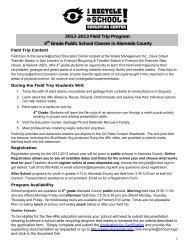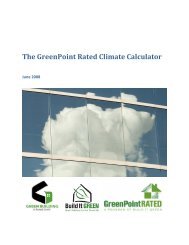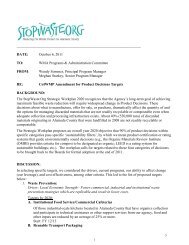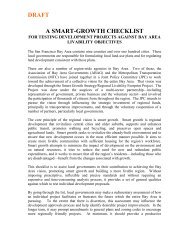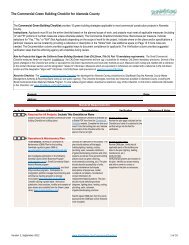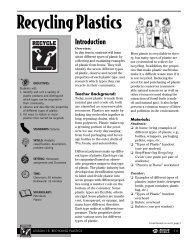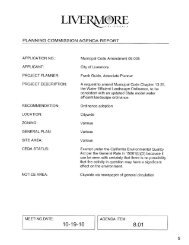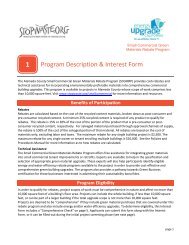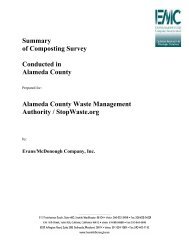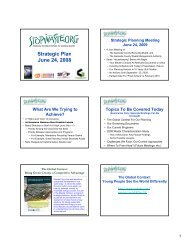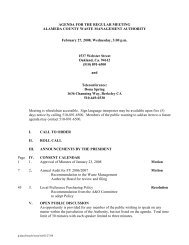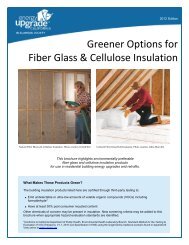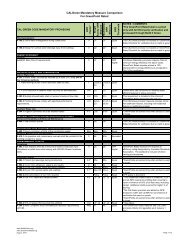Bay-Friendly Landscaping Principles and Practices - StopWaste.org
Bay-Friendly Landscaping Principles and Practices - StopWaste.org
Bay-Friendly Landscaping Principles and Practices - StopWaste.org
You also want an ePaper? Increase the reach of your titles
YUMPU automatically turns print PDFs into web optimized ePapers that Google loves.
<strong>Principles</strong><br />
& <strong>Practices</strong><br />
3. Minimize site disturbance<br />
Description<br />
In general, soil should have 100% plant<br />
or mulch cover, since exposed soil<br />
surfaces are highly susceptible to runoff<br />
<strong>and</strong> erosion, especially along slopes <strong>and</strong><br />
waterways. Often, natural hydrological<br />
features are destroyed by grading <strong>and</strong><br />
with the exception of a few large trees,<br />
native vegetation is typically removed<br />
from a site before building or l<strong>and</strong>scaping.<br />
Doing so exposes the soil to erosion, <strong>and</strong><br />
the resulting loss of topsoil depletes the<br />
soil of its <strong>org</strong>anic, living component <strong>and</strong><br />
clogs waterways. It turns nature on its<br />
head by turning a valuable resource into<br />
a pollutant.<br />
Applications<br />
n Design <strong>and</strong> implement a plan to<br />
defend against erosion, as described in<br />
Nurture the Soil.<br />
n Retain natural topographic features<br />
that slow <strong>and</strong> store storm flows <strong>and</strong>/<br />
or do not increase steep continuous<br />
slopes.<br />
n Limit overall cut <strong>and</strong> fill through<br />
efficient road design <strong>and</strong> lot layout.<br />
n Limit clearing to road, utility building<br />
pad, l<strong>and</strong>scape areas <strong>and</strong> the minimum<br />
area needed to maneuver.<br />
n Use mulch regularly. Place it in a way<br />
that keeps it out of stormwater.<br />
Benefits<br />
Vegetation, topography <strong>and</strong> hydrology<br />
is undisturbed <strong>and</strong> erosion is prevented.<br />
Sediment does not clog waterways.<br />
4. Choose <strong>and</strong> maintain your<br />
materials, equipment &<br />
vehicles carefully<br />
Description<br />
Lawn mowers, chain saws <strong>and</strong> leaf<br />
blowers emit significant amounts of<br />
pollutants. According to the US EPA, a<br />
gas-powered lawn mower emits 11 times<br />
the air pollution of a new car, per hour<br />
of use. In addition, operators are typically<br />
positioned where exposure to toxic<br />
emissions is greatest.<br />
Applications<br />
n Upgrade to low emission equipment.<br />
n Inspect <strong>and</strong> maintain all equipment to<br />
keep it performing optimally. Repair oil<br />
leaks immediately.<br />
n Don’t repair equipment on site.<br />
n Dispose of spent oil properly<br />
n Refuel carefully. Do not refuel near a<br />
creek or drainage area.<br />
n Consider your routes <strong>and</strong> always<br />
carpool to sites.<br />
n Specify low or zero VOC paints,<br />
sealants, solvents <strong>and</strong> adhesives.<br />
n Use sustainably harvested wood (FSC<br />
Certified) if plastic or composite<br />
lumber is not appropriate. Use treated<br />
wood that does not contain chromium<br />
or arsenic for any application that<br />
specifies treated lumber.<br />
Benefits<br />
Fuel consumption is minimized. Air, water<br />
<strong>and</strong> noise pollution can often be reduced.<br />
Worker <strong>and</strong> community health will be<br />
protected.<br />
5. Keep soil & <strong>org</strong>anic matter<br />
where it belongs<br />
Description<br />
Organic matter, added to the l<strong>and</strong>scape<br />
in the form of mulch or compost,<br />
supports soil microbial life, which filter<br />
out pollutants. But it can become a<br />
pollutant when it enters the stormdrain.<br />
Applications<br />
Amend soil with compost as described<br />
in the section Nurture the Soil. But be<br />
sure to keep <strong>org</strong>anic matter from being<br />
washed or blown into the gutter or<br />
stormdrain where it could become a<br />
pollutant by:<br />
n Using compost filter socks around<br />
stockpiled <strong>org</strong>anic matter.<br />
n Storing it away from creeks <strong>and</strong><br />
stormdrains.<br />
n Sweeping every day during<br />
construction.<br />
n Minimizing the use of blowers <strong>and</strong><br />
using them carefully so you are not<br />
removing topsoil.<br />
n Switching to gravel or cobblestone<br />
mulch in areas of high surface water<br />
flow.<br />
n Keeping fallen leaves, grassclippings,<br />
<strong>and</strong> other plant materials away from<br />
storm drains, creek banks, <strong>and</strong> the<br />
shoreline.<br />
Benefits<br />
Organic matter does not become a<br />
pollutant but rather, increases the soil’s<br />
ability to remove pollutants, thereby<br />
protecting our watershed. It also<br />
increases the soil’s pool of sequestered<br />
carbon dioxide.<br />
Why calendar-based spraying doesn’t work:<br />
n Over 2/3 of plant problems are not caused by any living pathogen. More often than not, the problem is from improper soil<br />
conditions, watering or fertilizing practices <strong>and</strong> other cultural problems.<br />
n If a pathogen or other pest is present, it must be treated at the correct point in its life cycle. Pest <strong>org</strong>anisms do not grow on a<br />
regular calendar basis. It is likely the timing of spraying based on the calendar would be too early or too late to be effective.<br />
n Timed sprays endanger the beneficial <strong>org</strong>anisms. Healthy l<strong>and</strong>scapes with a diversity of birds, insects, microbes <strong>and</strong> other<br />
<strong>org</strong>anisms can often keep pest populations under threshold levels, making chemical treatment unnecessary.<br />
Adapted From: ProIPM Fact Sheet, Green Gardening Program, Seattle, WA.<br />
46<br />
3



